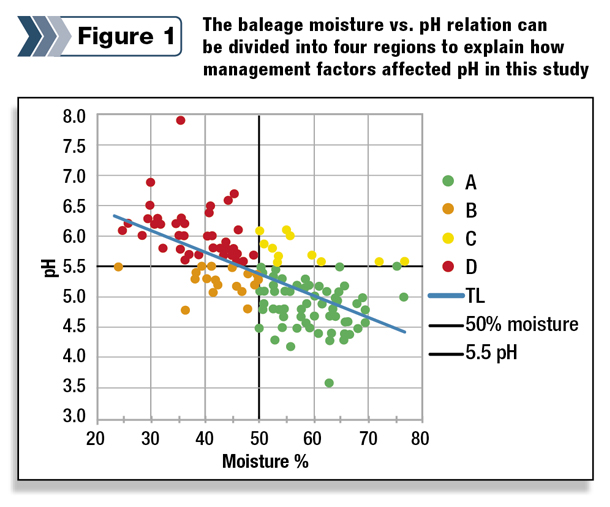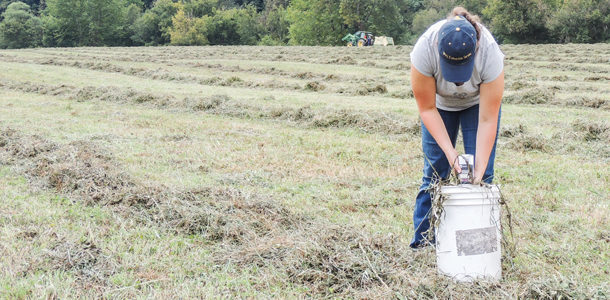For good acidic fermentation, the forage needs to have the proper bacteria present, have high sugar content that the bacteria can ferment into acid, be baled in a dense bale to remove oxygen from within the bale and then sealed off from oxygen with adequate plastic soon after baling to produce the anaerobic fermentation needed to form the acids and prevent secondary fermentation during storage.
In baleage, we would like a pH of 5.5 (preferably 5) or lower. In corn silage or chopped haylage, pH will be lower than in baleage since these crops and processing methods encourage greater fermentation and acid production than does long, uncut hay put up in baleage.
The chemical characteristics of the forage after fermentation are determined by the chemical and biological character of the forage at harvest, which is highly dependent on the environment at harvest and the management practices used in putting up the baleage.
The generally recognized best management practices for producing high-quality, plastic-wrapped baleage are:
1. Harvest high-quality early maturity forage which has a higher sugar content for good fermentation.
2. Mow forage in late morning or early afternoon when dew has dried off, without conditioning, into a wide swath for exposure to sunlight while wilting.
3. Wilt to 50 to 60 percent moisture to obtain the best fermentation.
4. Don’t ted hay since tedding leaves stems at random and parallel stems allow denser bales.
5. Bale a tight dense bale to reduce air (oxygen) inside the bale.
6. Wrap bales in plastic within two hours to exclude oxygen and reduce heat damage.
7. Wrap bales with at least a 6-mil thickness of plastic (8-mil is better), using 50 percent overlap and 50 to 55 percent stretch.
8. Store bales in a clean, relatively level area with no sharp stones. Stack bales to reduce sunlight exposure to save plastic and reduce sweating.
North-south storage orientation evens out sunlight on both sides of the bale. Set individually wrapped bales with the flat, multi-layer plastic end on the ground.
9. Inspect stored bales weekly. Repair tears and holes to prevent spoilage and secondary fermentation.
In a review of forage test analysis of baleage produced in West Virginia, we noticed a high percentage of samples had pH values higher than desired.
To determine why this was happening, county agents from West Virginia University extension service worked with 39 farmers to evaluate their baleage management practices and the effect management had on forage nutritive and fermentation quality. Baleage from 162 fields across three years was collected and analyzed.
Moisture levels
 Moisture had the single greatest effect on baleage pH. Baleage in the 50 to 60 percent moisture range had an average pH of 5.27. As moisture decreased from 50 percent, pH increased (Figure 1).
Moisture had the single greatest effect on baleage pH. Baleage in the 50 to 60 percent moisture range had an average pH of 5.27. As moisture decreased from 50 percent, pH increased (Figure 1).
Less mature forage, having higher total digestible nutrient (TDN) content, had better fermentation and a lower pH. Forage that was higher in crude protein (an index of high N fertilization) and neutral detergent fiber (an index to later maturity) had higher pH.
Heat damage in baleage
Poorly fermented baleage often overheats, resulting in the formation of neutral detergent insoluble crude protein (NDICP). The formation of NDICP increased in low-moisture forage and decreased in less mature forage.
High-CP forage was more subject to heat damage, probably due to more CP being available for formation of NDICP. Thus, it is critical to manage high-CP forage properly to prevent heat damage to this potentially high-quality hay.
Time of day at cutting
When moisture was greater than 50 percent, there was no effect from time of day on baleage pH. However, when moisture was below 40 percent, late-afternoon mowing tended to result in baleage pH over 6.
This is possibly due to overnight respiration using up fermentable carbohydrates, resulting in poor fermentation once baled.
Baler technology and baleage pH
On average, newer silage-type balers with variable-size bale chambers made baleage with lower pH. Variable-chamber balers averaged 0.23 pH units lower, while fixed-chamber balers averaged 0.64 pH units higher than average moisture-adjusted pH from all balers.
However, even hard-core balers (when the model was used on different farms) had moisture-adjusted pH, differing from 0.34 pH units lower to 0.65 pH units higher than average.
This is the same range in pH that was observed between baler types. What does this mean? Baler management is just as important as baler make and model. Farmers need to know how to adjust and use the baler they have to make the best-quality baleage possible.
Moisture meter
Moisture meters were used to measure windrow moisture. Some moisture meters are able to measure forage moisture in the range needed for making baleage.
There was some bias between the moisture measured in the field versus the lab. Moisture meters underestimated moisture when moisture was more than 50 percent and overestimated moisture when it was less than 50 percent.
At 50 percent moisture, where moisture meters were most accurate, meter readings were within 9 percent (plus or minus) of the laboratory moisture reading 66 percent of the time.
Summary
Baleage is a cost-effective means of producing stored forage allowing producers to make haylage with lower risk of rain damage than dry hay. It also provides excellent protection from storage losses.
To make high-quality baleage, producers need to harvest young, high-sugar forage, wilt it to 50 to 60 percent moisture, bale it in a tight bale and wrap it soon after baling with adequate plastic to get the best fermentation. FG
Acknowledgement: This on-farm research was accomplished through the efforts of county extension faculty and farmers cooperating in this study. Funding was provided through an Extension seed grant and a WVU Faculty Senate Service Grant.
PHOTO
Moisture meters were used to measure moisture in the windrow and generally underestimated moisture when moisture was more than 50 percent and overestimated moisture below 50 percent. Photo courtesy of Ed Rayburn.

- Ed Rayburn
- Extension Specialist
- West Virginia University










